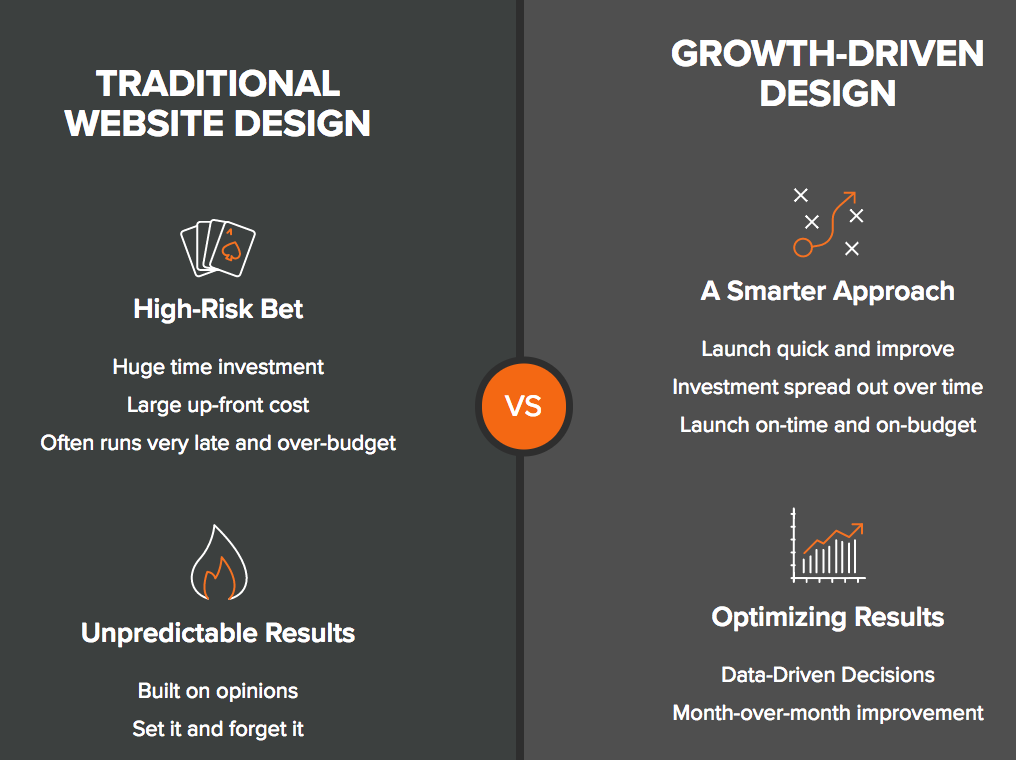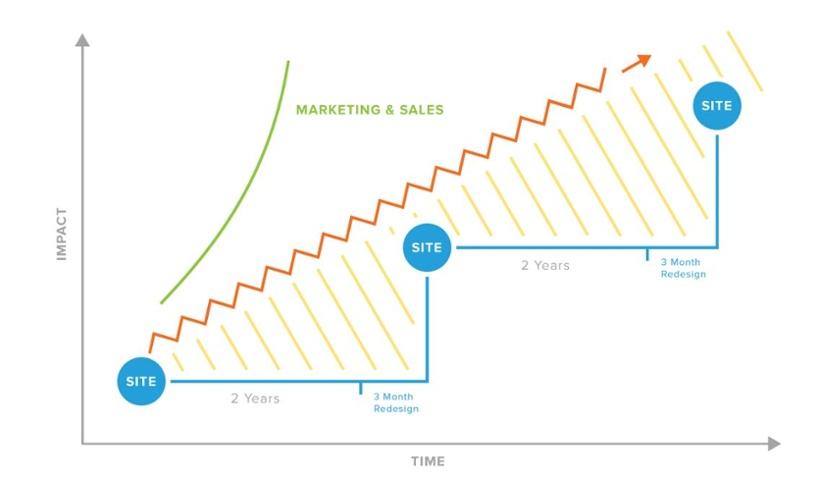

Thursday 27 September 2018,
by Jules Pancholi
As part of the design and development portion of our ‘full-service service’ offering, for the past 15 years, we’ve been building websites, apps, and other assets for Life Sciences companies. Using what we’ve learnt in the wider world of e-commerce and marketplaces our pitch has always been akin to this…
‘If we both want to be successful’:
1. We need to go on a journey together that will last for longer than we all think and will require us to start small and build up, increasing both the investment, range and complexity of activity over time…
2. We understand that strategies based on ‘build it and they will come’ just don’t deliver results consistently enough. Especially in a world where products are marginally (albeit often critically) differentiated and HCP’s, patient and consumers are busy.
3. We believe successful execution doesn’t rely on trying everything at once but by following a tried and tested order that allows us to think, plan and act with measurable purpose.
So why do so many projects end up being a race for the finish line with almost all energy and budget expended on the launch? 90% of Life Science built websites have less than 1000 users a month (including the corporate sites and US brand.com sites – based on data from thousands of sites). It always reminds me of the scenes at the end of a sprint race where the runners are hunched over or lying on the ground exhausted – except in our case, there is still a marathon left to run (in the form of visits, engagement, conversions etc…).
This problem has perplexed me. I hate waste and this is a waste. Not just of time but of money and resources. It impacts agencies ability to demonstrate the value that clients deserve and expect and more importantly stymies the very genuine impact that I believe digital can have on the healthcare system in terms of improving patient care, healthcare professional education and delivering Life Science companies business objectives.
There are of course many reasons for this; lack of overall digital strategy, limits of the channels within the regulatory environment, the complexity of user behaviour, inappropriate budgets to the task, lack of digital infrastructure, training etc. All of which is true in various ways.
Part in frustration, part in intrigue I decided to take the Hubspot Growth Driven Design certification and it’s prompted a lightbulb moment that, if you’ll tolerate me’ I’d like to expound upon.
For the past few years, we’ve successfully applied formal agile process to project delivery where possible. We’ve continued to operate ‘waterfall’ where clients have insisted but more often than not the predictable stress on all sides ensues. That’s not to say we don’t deliver, we do and the team regularly go the extra mile.
I’ve come to the conclusion that while the execution methodology described at the start of this post is solid we need a better framework for setting up the project, managing ideas through the process and establishing the ongoing nature of the collaboration that is required for success. I’ve found Hubspot’s’ Growth Driven Design methodology really helpful for doing that and I’d like to share why.
For those of you who have not come across it yet check out https://www.growthdrivendesign.com/
In summary, Growth Driven Design (GDD) ‘is a smarter approach to web asset design that eliminates all [I’ll say many, not all] of the headaches and drives optimal results using data.’

I particularly like this diagram from their site:

Growth Driven Design methodology works in a way that will be very familiar to agile practitioners with distinct Strategy, Launch (MVP) and Continuous Improvement phases.
1. It acknowledges that it’s strategy first even if it is ‘just’ a website. If you haven’t done the research then your starting hypothesis is going to be further off and you’re going to have to work extra hard making the asset work.
2. It’s evidence backed. The diagram above neatly summarises almost everything I’ve learnt about website development in the Life Sciences industry. Ie. we build sites, there is little marketing to the site, a couple of years later disappointed by the data we rebuild the site because of an assumed, but unclear cause.
3. It’s data-driven, any action has a target or outcome set and the investment in it assessed compared to the results, with the before and after being faithfully recorded in a helpfully provided spreadsheet (you might prefer your own services) to capture the learning points.
4. It’s creative – by structuring the process of ideation and sprint planning time can be dedicated to idea generation based on the data from the last sprint.
5. You create genuine collaborative momentum around it.
6. The courses for practitioner and agency are really very good, delivered in video format by the superb Luke Summerfield in a series of consumable and actionable videos.
7. It’s not just about websites, yes that’s in the language but it can (and should) just as easily be applied to creative projects, apps, events, campaigns, media…
8. You can organise around it, by, as we have, ensuring that everyone in the company is either qualified or is in the process of doing the courses. By asking clients to take it too we are creating organisational norms and nomenclature centred around Growth Driven Design and making clients true partners and participants.
9. It’s faster and people are more satisfied with the outcome. In a recent survey of 350 project engagements comparing GDD to traditional site build process, time to launch is cut on average by 40 days. Also, 74% of GDD clients said they are satisfied with the process compared to 62% for traditional.
All makes sense right? To most of you veterans, there will be few surprises here. The nuance is in the combination of the application of the framework with the tools it provides to set up collaborative working in a manner that is both easy to understand and executable and particularly the training.
We’ve done lots of successful agile development and marketing projects and in writing this I’m not claiming that Growth Driven Design is a panacea but in my opinion, it does raise the chances of successful delivery and creates greater value outcomes.
In addition to that, and here’s the key point’ when well executed it can play an amazing role in supporting clients digital transformation. This is important, not least because it’s a hot topic and a great business opportunity but mainly because this is a significant part of the value a client can derive from a well-executed Growth Driven Design project, especially in the Life Sciences when the ROI model for our digital activity is often less tangible than in traditional e-commerce.
Let me expand on that. Successful Growth Driven Design project execution relies on both client-side and partner side teamwork and collaboration. In order to achieve that shared learning of each other’s processes, skills, tech stacks and objectives are going to be required. This necessarily means skills will be transferred. Now if you take a traditional consultancy or agency model where the objective is to provide surge skills and keep resources allocated to a client with the consequent billing that’s very counterintuitive to the business model. My point is clients don’t really want that, that does not add value over and above the value of the outputs from the work done. These, of course, may well and should be valuable in themselves but true partners should add value to each other as well as delivering awesome projects. That’s how we think at Nitro and our experience of delivering Growth Driven Design especially within defined time frames bears that out. Successful execution in our opinion implicitly requires the mutual transfer of skills. That fundamental point is the one that requires a genuine commitment to at the start alongside the successful execution of an agile methodology.
In a recent 5 month project for a Life Science brand here are a few quotes (anonymised to protect the innocent)…
‘We have driven the organisation to start believing in GDD.’
‘Our project has progressed much better and further than other agile projects set up in [company] and is very visible.’
‘We raced past the rest of the business’
‘[The organisation transformation we have enabled] is pretty damn impressive. No one in the group knew anything about this and it is now part of the organisational language’
‘Nitro have been a key part of that [digital transformation] and I would endorse that’
If you’d like to find out how we can help transform the way you execute digital projects in Life Sciences or Wellness companies or riff on the Agile or Growth Driven Design we’d love to hear from you.
https://nitro.digital/get-in-touch
PS: before you ask – yes I did pass the Growth Driven Design test and no I’m not telling you my score. Despite my 21 years of digital marketing and development experience, I did not get 100%… which just goes to prove we can all learn!

